In surface irrigation methods, water is applied directly to the soil from a channel located at the upper reach of the field. Following are the general requirements of prime importance to obtain high efficiency in surface methods of irrigation:
- Properly constructed water distribution systems to provide adequate control of water to the field.
- Proper land preparation to permit uniform distribution of water to over the field.
- The land should be levelled well to achieve higher water application efficiency.
There are different methods of surface irrigation system as follows:
1. Free flood method
This is a common methods of irrigation of wetland rice where water may be applied as a continuous flood, rotational flood or an intermittent flood. This is a suitable method for an area where cheap and abundant supply of water is available. Flooding consists of opening a water channel in a plot of field, so that water can flow freely in all directions and cover surface of the land in a continuous sheet.
Advantages
- No other field layout become necessary except the levelling and preparation of impervious boundary bunds.
- No land area is utilized for water distribution. As a result, wastage of land becomes minimum
- Labour supervision is required for application of water in the field.
- Labour requirement is minimum.
Disadvantage
- It is the most inefficient methods of irrigation as only about 20 per cent of water is actually used by plants and the rest is being lost as run off, seepage and evaporation
- Levelling of land increases cost of cultivation.
- This method is unsuitable for crops that are sensitive to water logging.
- Crop growth is not uniform as the water distribution by this method is very uneven.
- There is a possibility of soil erosion.
2. Furrow Irrigation methods
This method is suitable for row crops like potato cabbage, cauliflower, brinjal, chilli, sugarcane, cotton, tobacco, tomato etc. water is applied in the furrows which are developed between crop rows in the planting and cultivating processes. There is usually me furrow between each row of crop. In orchards and widely spread vegetable crops, several furrows may be opened between the rows of the crop and the water is led simultaneously in all furrows. Furrows, are laid down along the slope when the slope of the land is about three per cent. The furrows are on graded contour when the slope exceeds three per cent and goes upto 15 per cent. The length of furrow varies with soil type, slope of the land and the quantity of water to l applied and may vary from 10 metres to 100 metres.
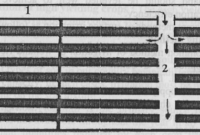
Advantages
- There is a great advantage in the use of water which is of great consideration in lift irrigation.
- This method is suitable for crops which are sensitive to saturated soil condition in the root zone.
- Water in the furrows contacts only one fifth to one half of the land surface, thereby reducing puddling, crusting of the soil and evaporation losses.
- Water is applied uniformly by this method.
- It is especially suitable to crops like maize that are injured by contact with water as water does not come in contact with the plant stem.
- The method reduces labour requirements in land preparation and irrigation.
Disadvantages
- Cost involved in the preparation of furrow is more.
- This method is not suitable for all areas, especially cannel areas.
- Uniform distribution of water in all furrows is not possible.
Following are the different types of furrow irrigation system:
- Straight furrow method of irrigation: This method is practiced in flat lands.
- Contour furrow method of irrigation: This method is practiced in sloping land in which the direction of flow is across a slope rather than down slope. The furrows are laid out with a gentle uniform grade to carry the irrigation streams.
- Corrugated furrow irrigation: Corrugations are small furrows which are used for close growing crops such as beet, cabbage, cauliflower, turnip, etc. In this system more and smaller furrows are utilized and crop rows are not necessarily related to the irrigation furrows. The size and spacing of corrugation vary with the soil. The corrugation should be more closely spaced, generally 45 to 90cm.
3. Check and furrow method:
It is a modified form of furrow irrigation. This method suitable for a land which is quite levelled. The water is lead in first furrow and the flow of water is continued to second furrow through a breach in the ridge at the terminal end of the run. After completion of the run in the second furrow, the terminal end of the flow is continued to the third furrow through a breach. A number of furrows are irrigated with a single run of water that moves in a zigzag way through furrows.
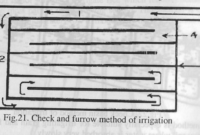
Advantages
- Water is applied uniformly and the wastage of water minimum. There is less evaporative loss from furrows.
- Soil gets sufficient time to absorb water.
- It is a very suitable method for irrigating row crops in level land
- Soil erosion is checked.
Disadvantages
- Uneven distribution of water in the different furrows,
- The method is only suitable for row crops.
- Irrigation cost is higher as it involves much labour.
- More time is required for irrigation.
4. Border or check basin irrigation:
The field is divided into smaller unit areas or beds measuring 10 to 100 sq metre or even more. Bunds or ridges are constructed around the areas forming basin within which irrigation water may be controlled. The basins are levelled in both directions. Small irrigation channels are provided between two adjacent rows of beds. Water is conveyed to the field by the stream of supply channel and lateral field channel. The supply channel is aligned in the upper side of the area and there is usually one lateral for every two rows of check basins Water from the lateral channel is turned in the beds and is cut oil when sufficient water has been admitted to the basin. The basins are filled to the desired depth and the water is retained until it infiltrates the soil.
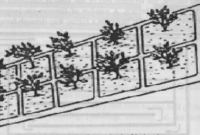
This method is especially suitable for irrigating grain and fodder crops in heavy soil where water is absorbed very slowly.
Advantages
- It is more efficient method of irrigation arid ensures uniform application of water.
- It has good control on irrigation water and high water application efficiency.
- Though the Initial cost is high, it requires less labour and has low maintenance cost.
- Wastage of water and soil erosion is reduced as there is bund around the basin.
Disadvantages
- There are too many ridges which occupy the larger area of land. It involves the wastage of land.
- Lay out requirement in land preparation and irrigation is much bigger in check basin irrigation as compared to other methods.
- Repairing of ridges and careful supervision during irrigation is needed.
- Uneven distribution of water within the plot.
- The method impedes surface drainage, precise land grading and shaping are required.
5. Border strip method of irrigation
The field is divided into a number of long parallel (3-10 ni x 50-30() m) strips which is called border. The border is separated with small parallel low ridges on the sides. The individual strips are levelled perfectly and each strip is irrigated independently by turning a stream of water at the upper elevation. The water can flow down the slope with nearly uniform depth. This method is suitable to irrigate all close growing crops like wheat, barley, fodder crops and legumes. But this method is not suitable to irrigate rice which requires standing water during most part of their growing season. This method is suitable to soils having moderately low to moderately high infiltration rate.
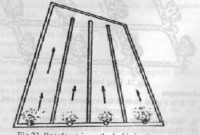
Advantages
- It is the best method to irrigate close growing crops.
- Uniform distribution and high water application efficiencies are possible if the system is properly designed.
- Labour requirement is less to irrigate the field.
- Operation of this system is simple and easy.
- Excess rainwater is drained out if outlets are available.
Disadvantages
- More labour is required for leveling of the field.
- Ridges cut down the neat cropped area.
- Large irrigation streams are required.
- Repair of ridges and supervision during irrigation are needed.
6. Ring Basin Irrigation Method
Ring basin irrigation is especially suitable for fruit and vegetable crops. A basin is made around the stump of the plant at a distance of about 30 -60 cm which may be square, rectangular or circular in shape. The individual plant or plant grown in pit is irrigated by this method. The soil around the plant is soaked with irrigation water and not the entire land. Generally ring basin is used for irrigating fruit trees. The basin is connected with irrigation channels for receiving water.
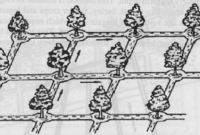
Advantages
- It is a good method for irrigating orchard plants and also for all types of soil.
- It is an efficient method in the use of water.
- This method economise the water considerably.
Disadvantages
- Initial cost for preparing basin is high.
- This method is not suitable for irrigating field crops and some orchard plants such as banana, papaya, pineapple etc.
- All plants do not get same amount of water.
Read more: Testimoni Mosehat Untuk Penderita Penyakit Diabetes.
